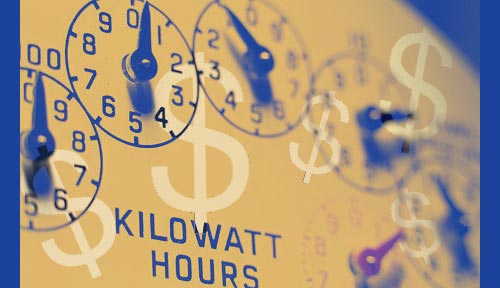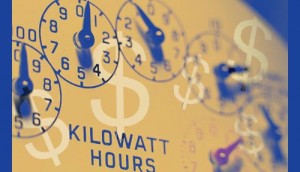David R. Tucker is a Project Director at the Environmental Finance Center at UNC Chapel Hill
It’s the season of Halloween, and for some, this time of ghosts and goblins, zombies and vampires can be scary. For others, trick or treating and costumes and parties are great fun. For still others, the scary news of late is higher electric bills. Here in our home state, the North Carolina Utility Commission (NCUC) has approved a 7.2% residential electric rate increase for Duke Energy Carolinas customers, and a similar 7.5% increase for Duke Energy Progress customers. However, the NCUC’s orders came with several other changes for Duke Energy, including the piloting of residential electric Time of Use (TOU) rates – the analysis of which is the sort of thing we at the EFC think is fun!
What is a TOU rate?
Also known as time-based rates, time-variant rates, time-based pricing, dynamic pricing, etc., TOU rates mean that the customer pays a different rate (per kWh of energy and/or per kW of power) depending on the season of the year, day of the week, time of day, or some combination thereof. TOU rates allow for a variety of interesting and useful things to happen, especially when paired with the customer installing a “smart” meter in the home, which can display in real time one’s electricity usage, and possibly some tracking data and summary statistics. (This can make possible demand response programs and technology by utilities and service providers, a growing area of the electricity market.) In general, utilities set TOU rates based on the idea of making electricity more expensive during times of peak, or high, energy/power demand, and cheaper rates during off-peak times.
Many of us don’t think about how the time of day/week/year affects the cost of providing us with electricity. But the variation in electric load for the utility is considerable for a utility to manage: on cold winter mornings, electric use can spike when we’re heating up our homes; on hot summer days, usage may increase in the afternoons and early evenings as we’re getting home from school or work and cooling down our residences. To compensate for this elevated load, utilities may bring online “peaker” plants, which are often fossil fuel based. Thus TOU pricing that leads to more efficient electric usage by customers can reduce peaker plant operation, promote cleaner air, reduce the likelihood of blackouts at peak times, promote integration of renewables and electric vehicles, and help keep costs down (for utilities and customers) by delaying the time until new electric plants and infrastructure need to be built. TOU rates can be a “win-win” for the environment, the utility, and the customer.
Opting into Duke Energy Carolinas’ pilot program of residential electric rates in North Carolina
Speaking of your wallet, how would opting into Duke Energy Carolinas’ pilot program of residential electric rates in North Carolina affect you? Let’s take a look. Duke Energy has had TOU rates for businesses in North Carolina since 1975, a phenomenon among electric utilities that was spurred on by federal legislation such as the Public Utilities Regulatory Policies Act of 1978 and Energy Policy Act of 2005. But residential electric TOU rates are something new (in least in terms of time of day; seasonal rates have been around for a while now) for Duke Energy Carolinas customers (those in the western part of the state). (Duke Energy Progress customers, in eastern N.C., have separate rate schedules, including some TOU rates, which may be the subject of a future posting.)
Duke Energy Carolinas’ new, optional, time-based rate Schedule RT (NC) is effective as of September 1, 2013, and is available for up to 500 Duke Energy Carolinas residential electric customers in the state of North Carolina. This is an alternative to the regular Schedule RS (NC), which has no daily or seasonal TOU rate structure elements. So, excluding various riders, taxes, or miscellaneous charges that get added to electric bills, let’s compare some sample bills under these two schedules.
- Schedule RS (NC) charges the customer a Basic Facilities Charge of $9.90 per month, as well as energy charges of 9.2896¢ per kilowatt-hour (kWh), with no difference for on-peak or off-peak. There are no power demand charges (measured in kilowatts (kW)) as part of Schedule RS (NC).
If that distinction (energy versus power) is confusing, think of energy (kWh) as the amount of “stuff” or electrons you use in total across the month, whereas power (kW) is how fast you are consuming those electrons in a given time period (assessed every 30 minutes throughout the entire month). That peak flow of power demand, across one 30-minute time period, is what you pay for the month as a whole. So if there were a 30-minute period during the month where you demanded 7 kW of power all at once, and the rest of the month it was down in the 5 to 6 kW range, you’re still charged for the 7 kW for that month. This is all about the utility charging according to the idea that they always have to be ready to meet your peak power demand, and that of all customers, simultaneously, at any given moment.
- Schedule RT (NC) – the one with the TOU rates, on the other hand, is a bit more complicated to understand at first. The Basic Facilities Charge is $5.00 per month higher than Schedule RS (NC), for a total of $14.90/month. The energy charges are divided into on-peak and off-peak rates, both of which are cheaper per kWh than for Schedule RS (NC). But the additional element of on-peak demand charges is added (differentiated by summer vs. winter), with zero off-peak demand charges. Rate Schedules RS and RT are summed up here:
DETERMINATION OF ON-PEAK AND OFF-PEAK HOURS:
Summer Months, June 1 – September 30: On-Peak Period Hours: 1:00 p.m. – 7:00 p.m., Monday – Friday
Winter Months, October 1 – May 31: On-Peak Period Hours: 7:00 a.m. – 12:00 noon, Monday – Friday
Off-Peak Period Hours: All year: All other weekday hours and all Saturday and Sunday hours. All hours for the following holidays shall be considered as Off-Peak: New Year’s Day, Memorial Day, Good Friday, Independence Day, Labor Day, Thanksgiving Day, Day after Thanksgiving Day and Christmas Day.
So, for a typical residential household in North Carolina, across the course of an entire year, which way would you save or lose money, between these two rate schedules? That is the question! And the short answer is “it depends,” since many assumptions must be made to make that determination. Here is a longer answer – though further research beyond this blog posting is clearly indicated.
Average monthly residential electric energy consumption in North Carolina is 1,124 kilowatt-hours per month (see here for the Environmental Finance Center’s 2011 report on this topic as well as for our online, interactive, N.C. Residential Electric Rates Dashboard). For the purposes of our analysis, we’ll round that off to 1,100 kWh/month, for simplicity’s sake. Average residential daily / hourly electric power demand is a much more difficult number to come by, as even the U.S. Energy Information Agency evidently does not track this statistic. However, to give us a starting place to model this data point, let us assume a range of 5 kW, 6 kW, and 7 kW for demand charges, based on this British study (though demand in an American home may vary from British experience, admittedly). As for Schedule RT (NC) – the TOU rates one – let us also assume a variation in the percentage of energy (in kWh) consumed on-peak versus off-peak of 40%, 50%, and 60%. (Actual residential electric power demand and energy used on-peak/off-peak might vary more widely, of course, depending on customer behavior.)
As you can see, there is considerable uncertainty about which schedule will be more affordable for the residential customer, RS or RT. Also, I modeled the demand and usage patterns for RT to be the same throughout the summer and winter seasons, whereas customer behavior might vary significantly from season to season and month to month. But in any event, the advent of a residential electric TOU rate schedule for up to 500 customers of Duke Energy Carolinas offers the opportunity for a very interesting pilot program. If customers in the pilot program are willing and able to shift a significant portion of their demand (e.g. by running some appliances sequentially across the day / week, instead of simultaneously) to times of day when the demand charge drops off completely, and if they are able to correspondingly shift a significant portion of their energy usage to off-peak times, the savings might be greater than shown above; or the revers might be true with customers whose peak demand and usage is even higher. It will definitely be interesting to see what the results of pilot programs like this one, as well as others such as Duke Energy Ohio’s pilot, turn out to be. For the times, they are a-changin’!








Please send me dates and hours of on peak/off peak hours.
I was assuming off peak started May 1 was 9:00pm- 10:00am am I correct?
Ramona Keys
I thought the peak usage hours for residential Durham was 10 a.m. to 7 p.m m-f but no peak on the weekends. I need to know when the peak usage hours are.